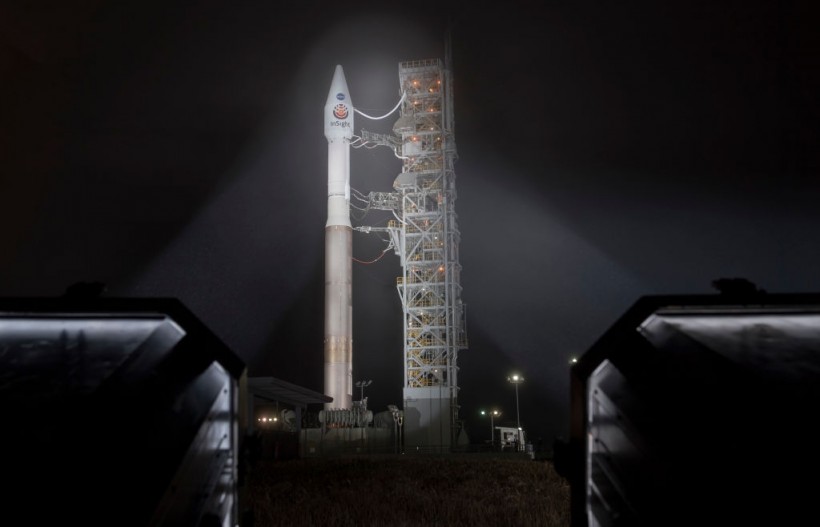The US Space Force is celebrating the successful launch of its Geosynchronous Space Situational Awareness Program (GSSAP) satellite, which will orbit the Earth and serve as a "neighborhood watch" to keep an eye on the world. The launch took place on the United Launch Alliance's Atlas V rocket from Cape Canaveral, Florida. It carried the satellite into orbit for its mission.
The recent mission (USSF-8) of the United States Space Force was a success. With the support of its partner, the ULA Atlas V, it achieved a new milestone in its attempts to launch the GSSAP satellite into orbit. The mission's primary goal is to get the cargo into orbit, which will be at a large distance from the Earth at 22,300 miles above the equator.

VANDENBERG AIR FORCE BASE, CA - MAY 04: In this handout provided by NASA, the United Launch Alliance (ULA) Atlas-V rocket with the NASA InSight spacecraft onboard is seen shortly after the mobile service tower was rolled back on Friday, May 4, 2018, at Vandenberg Air Force Base in California. InSight, short for Interior Exploration using Seismic Investigations, Geodesy and Heat Transport, is a Mars lander designed to study the "inner space" of Mars: its crust, mantle, and core.
Space Force's GSSAP Satellite Launch with ULA
Two Space Force tracking satellites were recently put into orbit by the United Launch Alliance (ULA). The satellites were put onto the Atlas V rocket, which launched at 2 p.m. EST on Friday from Florida.
Video coverage of the thrilling launch and information on the space mission was accessible on several networks.
LIFTOFF of the United Launch Alliance #AtlasV rocket with the United States Space Force-8 mission, delivering two space situational awareness satellites to geosynchronous orbit.https://t.co/bx75cXeWed#USSF8 || #GSSAP@SpaceForceDOD || @USSF_SSC pic.twitter.com/0yeVp7dmAa
— ULA (@ulalaunch) January 21, 2022
Defense's project has finally yielded results, as it has successfully reached orbit and established its capabilities to observe the Earth from a different perspective. DoD's space arm focuses on offering people a fresh perspective on the world, concentrating on the Earth's overall vision with reliable photographs that only the GSSAP satellite can produce.
ALSO READ: NASA, SpaceX All Set for the Undocking of Cargo Dragon from ISS to Return to Earth
According to The Drive, the two satellites will allow the Space Force to discover and identify objects in this far-off orbit and navigate near to them to inspect or analyze their capabilities.
— United States Space Force (@SpaceForceDoD) January 21, 2022
Space Force Tracking Satellite Explained
GSSAP-5 and GSSAP-6, two identical Geosynchronous Space Situational Awareness Program (GSSAP) satellites, are kept under stringent lock and key. On the other hand, UPI showed some of its broad capabilities to inquisitive admirers.
According to the report, the satellite systems are intended to improve knowledge of the geosynchronous orbit environment and further allow spaceflight safety to include satellite collision avoidance.
MISSION SUCCESS! ULA's #AtlasV delivered two surveillance satellites into geosynchronous orbit for more accurate tracking and characterization of human-made orbiting objects. Success #148 for ULA! Thank you to our customers @SpaceForceDoD and @USSF_SSC! https://t.co/9Si5nJ1XSs pic.twitter.com/fLQNIfYq10
— ULA (@ulalaunch) January 22, 2022
GSSAP satellites may also perform maneuvers in orbit, such as firing thrusters and getting close to unfamiliar objects to investigate them.
The two rockets will join four similar spacecraft orbiting Earth in high orbit. They will begin tracking man-made objects and other spacecraft in orbit once they are operational.
Watch ULA Space Force Rocket Launch Below!
The Atlas V rocket departure on Complex 41 at Cape Canaveral Space Force Station, Kennedy Space Center, was aired live by ULA. The US Space Force (USSF) - 8 mission was named after the US Space Force's Space Systems Command (SSC). This broadcast replay is available on their YouTube account, and the video link is included below.
RELATED ARTICLE: Atlas V Rocket Will Launch Early Tuesday Morning After a 48-Hour Delay Due to Fuel Leak
Check out more news and information on Space in Science Times.














